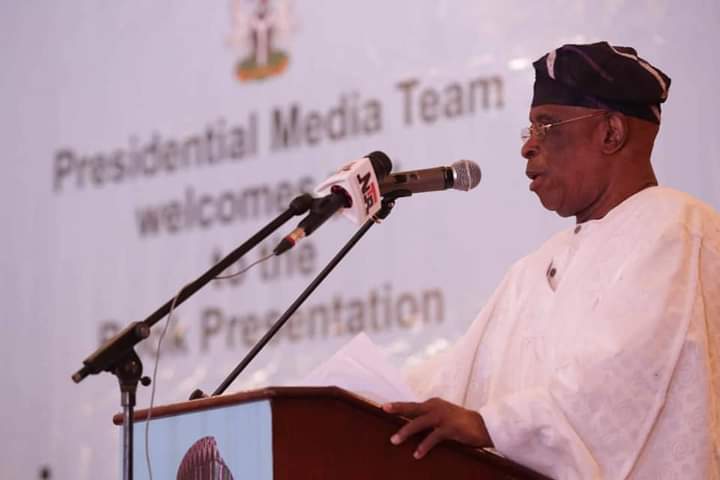Visible cracks on a retaining wall of the constructed section of bridge project
On May 15, 2019, Akinwunmi Ambode, former Lagos governor, flagged off the construction of a link bridge to connect the Ayobo-Ipaja and Egan-Igando communities in the Igando-Ikotun local council development area of the state. The idea of initiating the project was to shorten travel time for commuters while improving communal living for residents. Three years after, TheCable’s BUNMI ADULOJU visited the area to assess the level of work done on the link bridge.
With the sun beaming on the Tarmac-Agric link road in Egan-Igando, Alimosho LGA, Olawale Amos was focused on one goal — getting to his destination in the quickest possible time. He made his way along the pedestrian lane, intermittently adjusting his side bag.
Coming from the Ayobo-Ipaja community, Amos had just passed through the construction site of the Egan-Ayobo link bridge project contracted to Adeniyi Sarumi of Neesarm Ventures Nigeria Limited.
But in his previous journey to Ayobo-Ipaja, Amos had to take a different route — a longer one — because the workers had cordoned off the bridge. For him, it was a torturous journey that could have been avoided if the link bridge had been completed.
Advertisement
The longer route is a wooden bridge, constructed over five years ago as an alternative route linking the two community. It’s owned by private individuals who charge users N50 as toll fee.
“We have accepted our fate over the past few years,” Amos said.

“The construction work on the bridge project aimed at connecting communities in Egan and Ayobo-Ipaja and easing movement has been slow and we don’t even know its nature or understand what they are doing. But I recall it’s been there since Ambode left the government seat in 2019.
Advertisement
“For residents, making the trip back to Ayobo from different communities has been very difficult, especially when the construction site is sealed off and pedestrians have to do a merry-go-round to get to their destinations.”
RESIDENTS FRUSTRATED
Amos said the construction site is sometimes open to passers-by and motorcyclists, but not to motorists, as it is occasionally locked when the workers are on the site.
“All the same, while they are making life difficult for residents, we don’t really know what is delaying the work. They are making us feel the government is not giving them enough money to speed up the work. We believe that if the execution speed was the same as that of the Agric road done in 2019 by the same contractor, by now the link bridge should have been completed,” Amos stated.
Advertisement
Another resident of Ayobo-Ipaja, Macbeth Orji, said the delay in completing the project has made trips to Igando and surrounding communities problematic.

Orji recalled how she was turned back at the gate of the bridge one night and instructed to use the wooden bridge.
“Now, the N50 is not the problem, but the fact that the wooden bridge is far from my destination,” she said.
Orji eventually crossed the wooden bridge clutching her handbag to her chest, scared to the bones.
Advertisement
Like Amos and Orji, other residents who spoke with TheCable were united in demanding the completion of the project, which has caused untold hardship to the people.

Nnadozie Egwu, a frequent commuter, who once called the attention of Tracka, a civil society organisation (CSO), to the project, said apart from one section completed in 2019, work did not start again on it until the last week of July 2022.
Advertisement
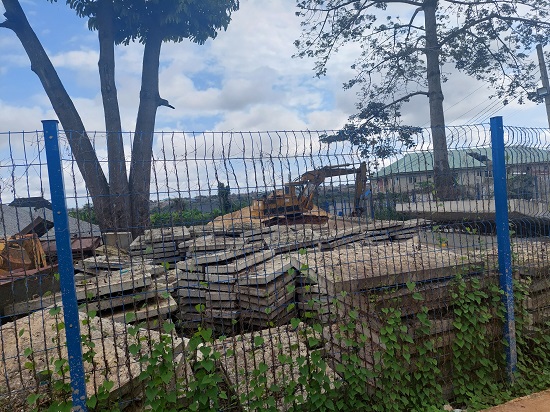
In their official comment on the project, sent to TheCable, executives of the Toluwani Community Development Association (CDA), said at their monthly meeting on November 5, 2022, that previous phases of the project were carried out by the same contractor, Sarumi.
“Work on some areas of the bridge was supposed to start three streets away from its present site, that is, 350 metres long, but the contractor reduced it from 350 metres to 150 metres. Worse is that he has done nothing on the 150 metres,” the CDA said.
Advertisement
The community said the contractor blocked both ends of the street at the constructed portion, making commuting harrowing for the residents. The CDA said it made efforts to call the contractor’s attention to the issues, “but he does not listen to us”.
Rather, the CDA said the contractor chided community members for not being appreciative of his efforts, arguing that the state of things in the area had improved since the inception of the project.
Advertisement
“We cannot just go to him again because he had told us off before now. The Lagos state government should send its delegates to the construction site. So far, we have not seen government officials monitoring the project. If they had come, they would have gone round to see things themselves and asked him to see the CDA executives,” the association said.

A document containing outstanding liabilities of the Lagos state in May 2019, obtained from the government’s website, showed that as of April 4, 2019, N1.59 billion was intended to be released for the construction of the Egan-Ayobo link bridge.
THE CRACKS
When this reporter visited the construction site on October 2, adults and children were frolicking around a stream in between the bridge in flagrant disregard of a prohibition sign mounted at the location, which warns: “Unauthorised entry to this site is strictly prohibited”.
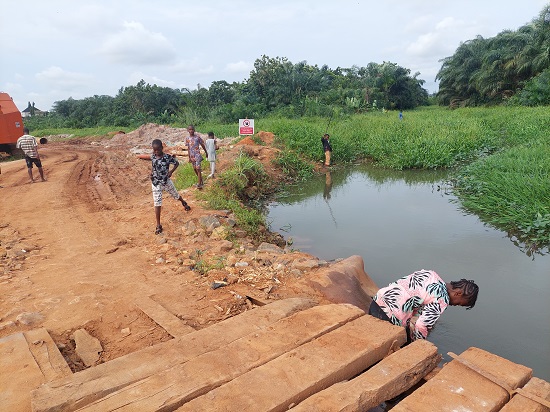
The reporter had observed on previous visits that though there were workers, materials, and machinery on site, a bulk of the work still remained undone for a project that has spanned over three years. While a few workers were seen working on the site, others were sitting, some walking about.
An artificer, who identified himself as an employee of Pill Engineering Limited, said his company was contracted by Sarumi in July to do the piling work at the site.
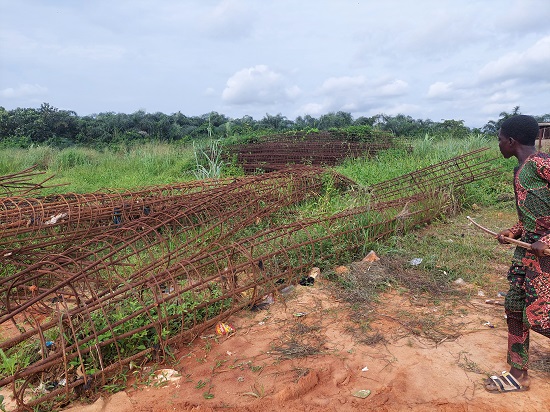
Meanwhile, it was observed that rusted piles of steel, as well as iron rods, some covered with weeds — apparently because they have been at the construction site over a long period of time – were scattered all over. At the store, granite, gutter cast, cast rod, and other pieces of machinery, were also seen.
While touring the constructed section of the bridge, visible cracks were also seen on retaining walls.
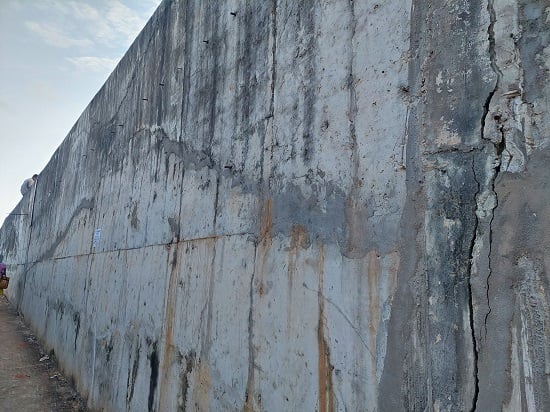
Omoosebi Jibola, a civil engineer, said it was abnormal to have such cracks on the bridge.
“Regardless of the year or when a project is constructed, cracks are not normal in any civil structure, whether it has been open for use or not. But before we can know what led to these cracks, we need to meet with those officials that worked on the project,” Jibola said.
Speaking further on possible causes of the cracks, the engineer said the materials that were used for the construction work, including concrete and enforcement, might be substandard.
“A lot of things can cause the cracks, ranging from the material test, integrity test on the concrete onsite, and concrete workability,” he said.
“It could also be as a result of differential settlement on the foundation. This occurs when the proposed site for construction is not suitable for the intended structure coming up on it. So, it is ethical to carry out a feasibility study,” he said, adding that soil tests and other essentials should have been done before the construction work began.
Agboola Agbogunrin, an Egan resident and former chairman of the Bolorunduro street community, just beside the project, said: “We actually saw the wall of the bridge crack some time ago. The contractor just brought bricklayers to plaster it, as they do with storey buildings. I have never seen a bridge constructed like that in my entire life.”
“At the time they started this project from Igando police station, nobody knew it would drag like this. It is an unfortunate matter because we have been living on this street for 30 years and the street is a link to the road, but now, the entrance to my street is blocked due to this project.
“In fact, residents once sent a petition to the relevant government agencies calling for the provision of an alternative route for the street. As we speak, every vehicle that comes here has to go through the end of this long street to enter the next street.”

He claimed that a defective drainage system on the constructed section of the bridge has affected some streets, causing them to be waterlogged, especially during a heavy downpour. He added that flood water also flows from other streets, exacerbating the residents’ woes.
When this reporter visited the contractor’s office in Ikoyi, the front desk officer said none of the top officials was around. The reporter was then asked to drop her business card. She did, but no response has been received from NEESARM till now.
Later, an email was sent to the company’s official mailing address, requesting the project status, but this also has not been honoured. But a top worker of the company, who preferred anonymity because he said he was not authorised to speak on the issue, commented on the cracked retaining walls.
“Work is still ongoing at the site and maintenance will be done on it. We also noticed that vehicles have been using the bridge, which should not be so because it is not open for use yet as that could pose danger,” he said.
On the project timeline, he said the delay could be traced to the specification of the government because “it is the client and it is the way they want the job to go that it will go.”
IN SEARCH OF ANSWERS
Auwal Musa, executive director of the Civil Society Legislative Advocacy Centre, said every contract is expected to have major principles that should be binding on public contracting.
“An issue around efficiency is that the government must ensure that the project provides positive results and must ensure that it is being carried out as efficiently, and as calmly as possible,” he said.
Noting that non-completion of projects at the stipulated time is a financial burden, Musa said, “There must be no wastage of financial, material or even human resources in public procurement projects because that would have defeated the purpose and would give room to lots of inflation and contract breach.
“That’s why you would see a contract that ought to have been finished in, maybe one or two years, being prolonged to five to seven years, and the initial amount budgeted for it would have gone up remarkably without achieving anything. Any public contracting must have sound planning for its commencement, as well as its completion.”
Titilope Anifowoshe, executive director, Eagles Foundation for Humanity (EFFH), said the government meant well to have commenced the project, “but when something that should serve communities is delayed for this long, it is stripped of its worth.”
“For every season that this project is delayed, it is adding to its cost. Are we saying that the tools they have there have not lost their quality? Who would then bear the cost of the damages, the contractor or the Lagos state government?” Anifowoshe said.
She posited that the Lagos judiciary would be in the best position to settle the grievances of the community residents, as she advised them to sue both the government and the contractor.
On September 26, a freedom of information (FOI) request seeking the latest details on the project was sent to the Lagos state ministry of work and infrastructure. The reporter was subsequently invited to the ministry on October 21.
A top female official told the reporter during the visit that the response to the FOI would be “lacking in context” if the ministry had replied to it, which necessitated the personal invitation.
She said the project faced various challenges when the current administration came into office, adding that the discovery of the site’s poor soil quality during the course of the project called for proper planning. She also spoke of the ministry having to deal with inflation because of the extension of the project timeline.
When asked about the quality of work on the constructed section of the bridge, the official threw the deficiencies at the former administration but assured that maintenance work would be done on it.
The reporter was not handed the relevant documents during the visit, but sent a reminder text and made follow-up calls.
Ordinarily, the FOI response should have been received not later than seven days from the date of receipt of the application, as required by the FOI, 2011, but a response is still being expected from the ministry as residents continue to groan in frustration.
This report was funded by the McArthur Foundation for the International Centre for Investigative Reporting (ICIR) OCR project.
Add a comment



